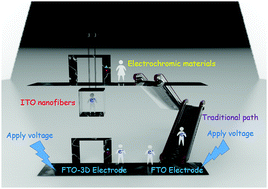A transparent 3D electrode with a criss-crossed nanofiber network for solid electrochromic devices†
Abstract
Low response rate has always been a major obstacle for use of electrochromic materials in electronic displays. An ideal 3D electrode capable of increasing the response rate and decreasing the diffusion distance of charge for solid electrochromic devices has been proposed and long-awaited. Here, we are glad to report a network-like transparent 3D electrode consisting of criss-crossed indium tin oxide (ITO) nanofibers fabricated by a rapid and facile electrospinning. In this transparent 3D electrode, the nano-porous fiber-network of ITO served as various criss-crossed electron channels to transmit both electrons and ions from their networks to fully surrounded electrochromic materials. Compared with the device based on common 2D fluorine tin oxide (FTO) electrode, the response time of the device based on this new electrode (FTO-3D) is reduced dramatically to less than 1/4 (1/30 in milliseconds scale) in this solid dual-mode device, wherein a BQ/Flu system is used as the electrochromic material based on electrobase theory. And, the conductivity of this FTO-3D device was more than 10 times better than normal FTO devices. Furthermore, this dual-mode electrochromic FTO-3D device exhibited excellent reversibility with nearly no degradation detectable after 2100 cycles.



 Please wait while we load your content...
Please wait while we load your content...